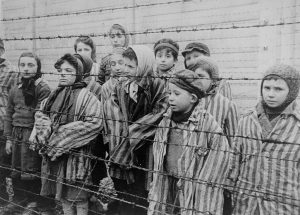6.3 The Holocaust

Jewish people have been the subject of prejudice and discrimination for centuries (History.com Editors, 2009b; Ludwig, 2016; The Holocaust, n.d.). The Holocaust, which occurred during WWII, is not only the most horrific example of anti-Semitism, it is the largest known genocide in human history (The Holocaust, n.d.; Roser et al., 2016; Sen Nag, 2018). During the Nazi movement’s rise to power, Hitler targeted the Jewish population of Germany using a four-step process of dehumanization (Toth, 2020):
- Prejudice (e.g., propagating the belief in the “inferiority” of Jewish people and the “superiority” of “native born Germans”, especially “Aryan” people, etc.) (Ludwig, 2016).
- Scapegoating (e.g., Jewish people were blamed for: Germany’s defeat in WWI; most social and economic problems leading up to and during WWII, etc.) (Ludwig, 2016; The Holocaust, n.d.).
- Discrimination (e.g., boycotting of Jewish owned businesses; excluding Jewish children from public education; passing discriminatory laws; expulsion from professions and opportunities to earn a living; forced wearing of a yellow Star of David; isolation and segregation, etc.)
- Persecution (e.g., the forced removal from homes; belongings and assets confiscated; forced to live in crowded “ghettos” with inadequate living conditions that took the lives of hundreds of thousands of people, etc.) (Brooks, 2019; Warsaw Ghetto, n.d.; Toth, 2020; United States Holocaust Memorial Museum, n.d.).
The dehumanization and isolation of Jewish people in ghettos, was part of the Nazi’s “final solution” to the “Jewish question” (Brooks, 2019; Warsaw Ghetto, n.d.; The Holocaust, n.d.). The next part involved deporting large numbers of people to concentration camps and ultimately mass executions (Boissoneault, 2016; Brooks, 2019). When Allied soldiers began liberating the camps in 1945, they witnessed the horror of the Nazi crimes including: hundreds of thousands of starving and sick prisoners living alongside thousands of dead bodies (Taylor, 2011; Brooks, 2019); gas chambers and high-volume crematoriums; thousands of mass graves; documentation of horrific medical experimentations; as well as other war crimes and crimes against humanity (Taylor, 2011; Brooks, 2019). By the end of WWII, the Nazis had killed over 6 million Jewish people, along with 5 million people from other minority populations including: Romani people, communists, members of the LGBTQ+ community, and people with disabilities (Buchholz, 2021; History.com Editors, 2009b).

VIDEO: They’re Taking us to our Death’: How a Teenage Girl Escaped the Nazis
In this video Rose Lipszyc, a Holocaust survivor and educator, shares her story of how she escaped the Nazis.

